Itaparica Island, located 15km from Bahia’s capital Salvador, is not as well known as Morro de São Paulo or the increasingly popular Boipeba Island. However, with its lush green forest, coconut trees, and crystal clear waters, it falls nothing short of the more famous islands in Bahia. This post contains a detailed travel guide for Itaparica in Bahia: relevant information on how to get there, how to find yourself around, and what to do. I have not come across much information in English about the island, so I hope this blog post will be helpful to you.
As said, Itaparica Island is less well-known than other touristy places in Bahia, and for me, this is the charm of Itaparica. Itaparica is a perfect getaway from mass tourism and high-rising hotel buildings. Locals love Itaparica Island and go for a weekend escape or spend their holidays there. If you seek to immerse yourself in an authentic Brazilian experience, visiting Itaparica Island in Bahia is a beautiful way to do so.
Each time I visit Brazil, I visit Itaparica to spend time with my parents, living the local life. I hope to give you a good overview with practical information and things to do on Itaparica Island.
Table of Contents
How to get there
There are a few options how to reach Itaparica Island in Bahia. I prefer taking the ferry even though it takes a bit longer to arrive because recently I’m getting sea sick easily.
- By ferry boat: You can take a ferry from Salvador at the terminal São Joaquim to Bom Despacho, the final and only stop until Itaparica. The ferry costs R$5.10 p.p from Monday to Friday and R$6.70 p.p on weekends and holidays. The duration is about 1 hour. With the ferry you can also travel by car. Vendors sell snacks and drinks inside the ferry, and you have bathrooms available.
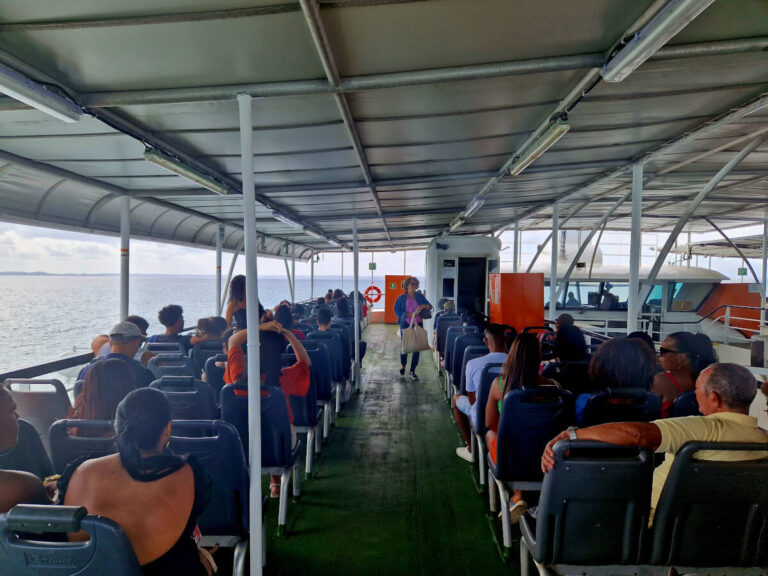
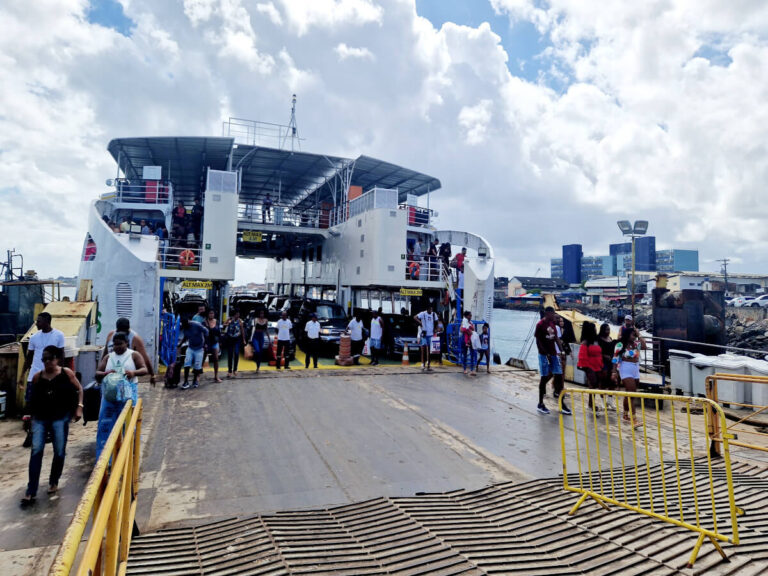
- By speed boat (lancha): You can take a speed boat from Salvador to Itaparica. Go to terminal Náutico. The lancha stops at Terminal Vera Cruz, in Mar Grande. The speed boat costs R$6.10 p.p and R$8.20 on weekends and holidays. It will take 30 to 45 minutes to arrive in Vera Cruz. When the wind is too strong in the area, the speed boats interrupt their services until the wind is weak again.
- By bus: if you come from the south or east, this can be a good option since you only need to cross the Funil bridge to enter the island. If you are in Salvador, there are better options than this because the trip will be more extended. The main bus companies operating in the Terminal Bom Despacho in Itaparica are Cidade Sol and Aguia Branca.
How to get around on the island
The best way to get around on the island is by car. There are no apps such as Uber. There are also no trams or buses. The buses on Itaparica are intercity, but no bus can take you from one place to another on the island. If you don’t have a car, you can catch a minivan taxi (kombi) or taxi at the terminal when you arrive. The van will take you to the part of the island where you need to go. It doesn’t stop from door to door, but it will bring you to the bus stop of the part of the island where you need to go. The price depends on your destination. For example, taking a van from the terminal to Barra Grande costs R$ 7. You can pay by PIX (you need a Brazilian bank account to use this application) or cash only.
When to visit the island
I recommend visiting the island in summertime (September – March). The rainy season is from March to August, and June is very wet. Visiting the island during that time might be tricky because the rain limits movement on Itaparica in Bahia. Because of possible flooding, you won’t be able to get to all parts of the island. Besides, the tides will be too strong, and you won’t be able to swim.
Another reason to visit during summertime is that many restaurants and bars don’t operate during the low season simply because it doesn’t pay off to open when there are only a few tourists. You don’t need to worry that the island will get too crowded during the high season. While tourism exists, it’s still low-key and doesn’t get too crowded.
Where to stay on the island
The old town of Itaparica in the north is the most tourist and developed part of the island. Watching the sunset from the beaches in the old town is very beautiful. Vera Cruz is the part of the island with the most commerce; it’s the hub for those looking for services or products.
As you go south, the local vibes of the island start to show up more. Most tourists visiting Itaparica stay in the old town and Vera Cruz. If you want to escape from touristic vibes, the center and south of the island are the best options.
Parts of the island, like Barra Grande, Barra do Gil, and Cacha Pregos, are visited mainly by locals and friends/family of the local inhabitants. These places are the most authentic vibes you can get.
What you need to know before visiting Itaparica
Itaparica Island in Bahia offers you an authentic experience. And genuine in a Brazilian context doesn’t mean a well-developed infrastructure with all commodities for tourists. This is the charm of Itaparica – at least to me. After spending a few months on the island, I have learned a thing or two and will let you know what you need to be aware of when visiting Itaparica Island.
Some of the points mentioned below apply to Itaparica and the entire Brazil. In this blog post, I wrote about 11 things you need to know before visiting Brazil, where you can get more information about first time visiting Brazil.
Condition of roads
While driving on the main roads is completely fine, there are many unpathed ways when wanting to explore more secluded parts of the island. You’ll need to drive carefully to not damage your car.
Language barrier
Few people speak English in Brazil, and even fewer in Itaparica. Local tourists mostly visit the old town in Itaparica, so service provision could be more accommodating for English speakers there but don’t expect having more than basic conversations. But Brazilians are open, and it’s easy to communicate with them even without Portuguese skills.
Avoid the rainy season
Visiting Itaparica during the rainy season is tricky. Main roads are pathed ways, but nearly all side roads are dirt roads. Heavy rainfalls flood the streets, and you might not access all parts of the island. Therefore, avoid visiting Itaparica during the wettest months (see when to visit Itaparica).
Lack of information available online
Besides the departure times of the ferry and speed boat to and from Salvador, you cannot find much information about Itaparica online. For instance, you cannot find information about the departure times of vans that will bring you from one point to another because they do not exist.
You also cannot book day tours within the island online. There are several people offering rides to bring you to different parts of the island, but to find them you need to talk to the locals and ask around for their Whatsapp number and close a deal.
Local cuisine
Obviously, seafood is the thing on Itaparica Island. The tradition of fishing is well-preserved. In addition to daily fresh fish, shrimp, and crab, you can eat all the local food Bahia has to offer. From acaraje to moqueca, on Itaparica island, you can find everything. The food on the island is fantastic. It’s not yet that commercialized; Brazilian aunty and grannys cook homemade, fresh food often in their own house that they sell. This adds to the authentic experience!
Limited public transportation
I already mentioned that no Uber or bus takes you around the island. It might be tricky to move around with no car. If you want to explore the island properly, you’ll need to rent a car to see most parts.
For peace of mind while traveling or living abroad, consider SafetyWing's health insurance. Their Essential plan covers travel and medical emergencies, including adventure sports and electronics theft. The Complete plan adds routine healthcare, mental health support, and maternity coverage worldwide, including your home country. Both plans are ideal for ecotourists and digital nomads.
8 things to do on Itaparica Island
Enjoy a BBQ at Praia de Catu
Catu is one of many fishing villages with colorful boats on Itaparica Island. There are various bars and restaurants. Provided wooden tables at the beach make this a perfect spot for BBQ.

Praia de Barra Grande
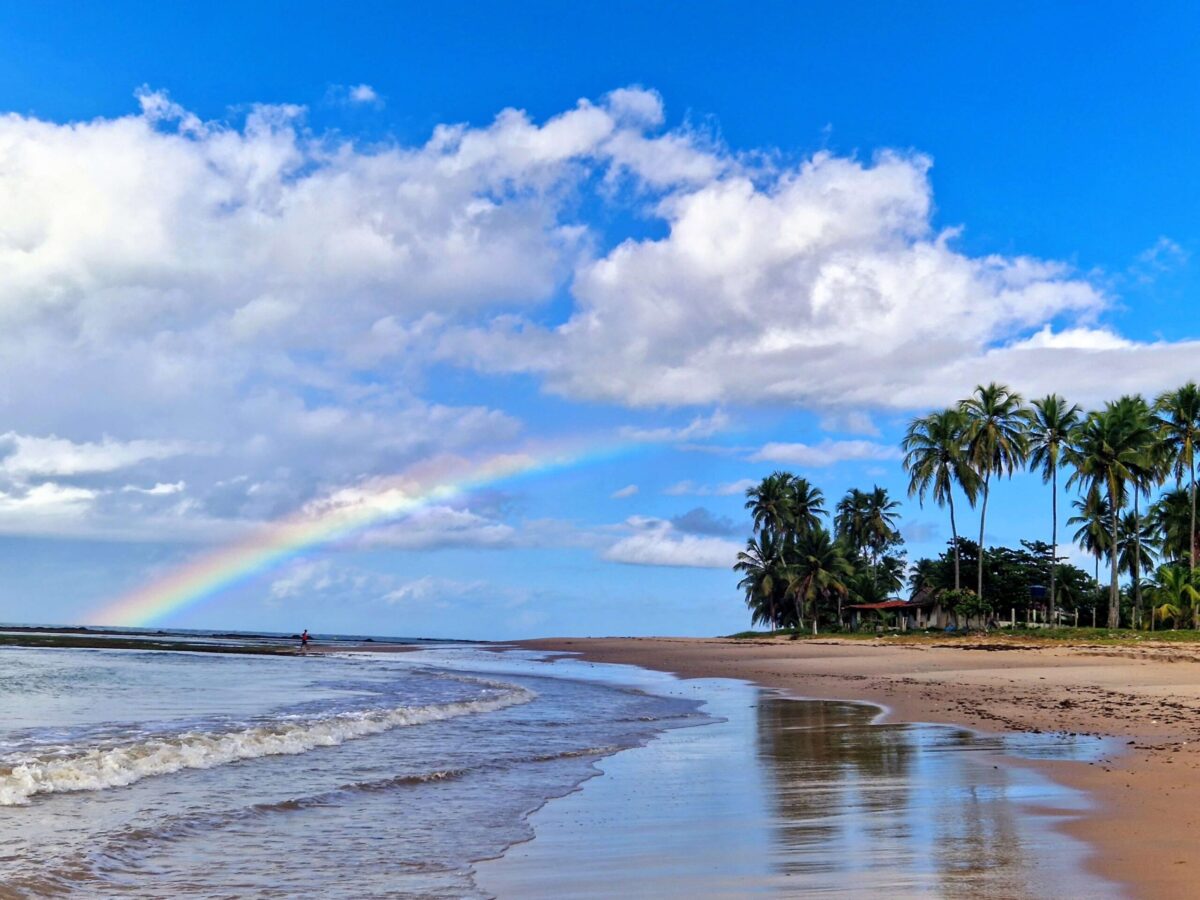
I admit I might be biased when I say that Barra Grande is my favorite beach because my parents live there, and I always enjoy spending time with them. But this part of Itaparica has crystal-clear water surrounded by coconut trees – how could not everyone fall in love with Barra Grande? It’s a very local and authentic place: in the mornings, you can observe fishermen going to the sea or people taking a walk at the beach.
Another reason I like it that much is because it’s very local and authentic. Brazilians with few means live there; it differs from the part of Itaparica where wealthier people live.
In the center of Barra Grande, you can find several supermarkets, a pharmacy, bakeries, bars, and restaurants.
Visit the famous Morro de Sao Paulo
While visiting Itaparica in Bahia, why not do a tour of the famous Morro de Sao Paulo Island? It’s considered one of the most beautiful places in the country, so it’s worth checking out.
There are several options for reaching Morro de Sao Paulo from Itaparica Island. Here are some common ways:
- Catamaran boat: You have these boats leaving from the Mercado Modelo in Salvador, so that means you need to take a speed boat or a ferry to Salvador, and after that take the catamaran to Morro de Sao Paulo. The companies Ilha Bela and Biotur offer rides every day.
- Bus + Speed Boat: At the Bom Despacho Terminal, you can take a bus to Valenca and stop at the maritime terminal. Be aware that the bus doesn’t stop directly at the terminal, so you must tell the driver you will stop there.
- Car + Speed Boat: From Itaparica, you will drive around 2 hours to the Atracadouro Bom Jardin. There you can take a speed boat to Morro de Sao Paulo. It is not possible to bring a car to Morro de Sao Paulo, so you need to find a parking lot in the Atracadouro and leave it there until you return.
Barra do Gil
If you just can’t get enough of coconut beaches, then you must visit Barra do Gil. It’s a beautiful beach with many options to eat close by. This part of Itaparica is popular among tourists and locals.
You can walk along the coast to explore the lovely chapel ‘Capela de Nossa Senhora da Penha.’ The opening hours are unclear, but we walked around the chapel and enjoyed it very much.
On the way to the chapel, you will see many fancy houses in condominiums. This is another side of Itaparica that you can see: How the better-off Brazilians live.
Praia de Aratuba
Due to the many rocks in the sea, Aratuba Beach is not the most well-suited for swimming, but the beach is beautiful and ideal for a romantic walk.
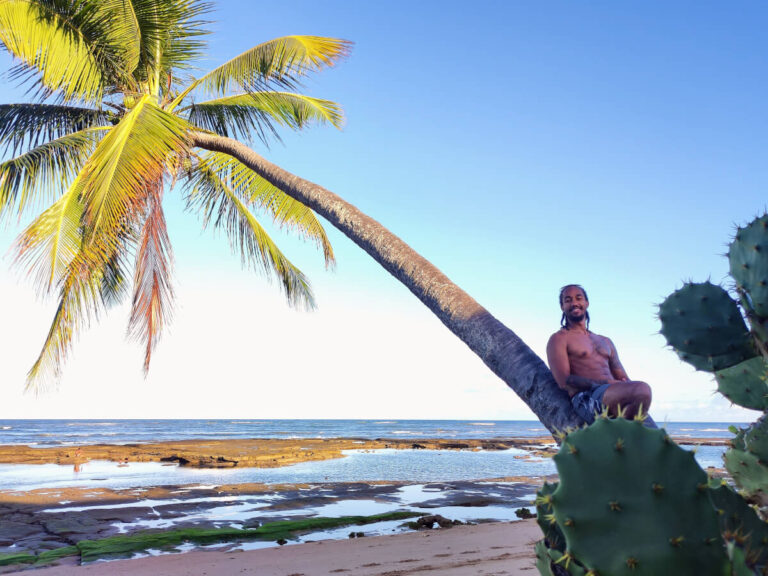
Do a day tour from Matarandiba to Cacoes
Going to Cacoes can be an excellent day tour. It’s a beautiful way to discover a more secluded place on the island. However, to get there is not straightforward, so here’s how to do it:
You have to drive to Matarandiba Beach. Once you arrive there, visit the main square, and some local fishermen will approach you. They will offer you to drive you to Cacoes by boat. They charge R$ 20 to bring you to Cacoes. During the high season, it’s R$ 25. If you don’t get your drinks, the local fishermen will buy drinks for you (coke, water, and beer) and transport them in a cooler (thermal bucket). For this, they charge R$ 50. However, you don’t need to order the drinks if you don’t want to.
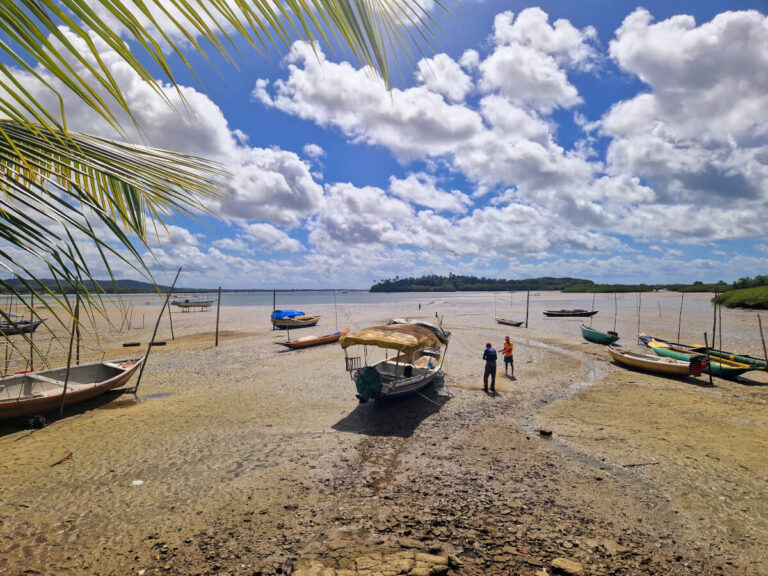
When you’re ready to go, the first stop is Tororo waterfall. The ride to Tororo waterfall takes around 10 minutes. It’s a pretty waterfall, and you can spend some time there to refresh, swim in the ocean, or explore that part of the beach walking. You need to know that there is nothing except nature: no toilet and no shop to buy anything.
When you had enough refreshing at the waterfall, the fisherman who drove you to Tororo will bring you to Cacoes.
Cacoes is a part of the island where a few people live. Once you arrive there, you’ll see that there is only one restaurant. I ate delicious Bahian food there. Overall, I had a very local experience on this day tour.

Eat in Manguezal restaurant
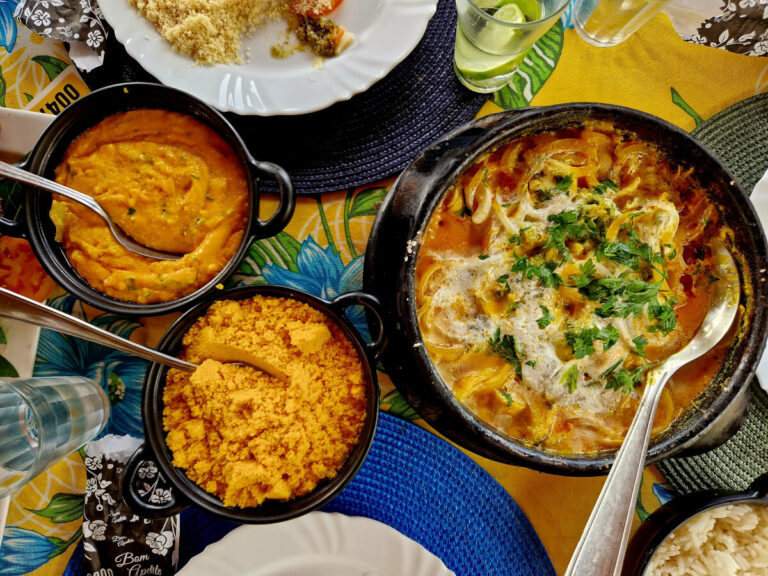
Enjoy a meal or drink at Manguezal restaurant directly at the beach. You can eat elsewhere for a better price and better food, but on Itaparica Island, this restaurant has the best ambiance, so it’s worth checking it out. We recommend going there for a drink only so that you can save your money on the overpriced food. The drinks are incredible!
Conclusion
While Itaparica Island in Bahia is less well-known and developed than other top tourist places in Brazil, for me, this is the charm of Itaparica. Visiting Itaparica will allow you to immerse yourself in an authentic Brazilian beach vacation.
You will learn how Brazilians enjoy a few days off, eat local Bahian food, and watch fishermen go about their business, all while avoiding mass tourism. However, as international tourism is relatively low-key, you need to keep an open mind and know you will only encounter some of the commodities you might expect in a tourist hotspot.
Are you curious about visiting Itaparica in Bahia? If so, I hope this blog post will help you plan your next adventure and discover this hidden gem in Brazil.








